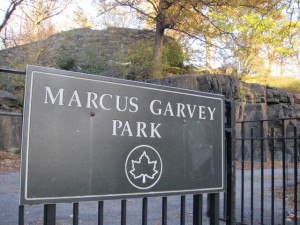 Just call it a tale of two parks.
Just call it a tale of two parks.
While Marcus Garvey Park in Central Harlem received a score of 91, up from 64 two years ago, on the Report Card on Large Parks by New Yorkers for Parks, St. Nicholas Park, on the west side of Harlem, is in decline, dipping to a 77 from a score of 88 on the last report.
The change in the two parks shows that there simply aren’t enough resources to go around to keep large parks functioning at a high level, said Holly Leicht, executive director of New Yorkers for Parks.
“The pie is too small to address the issues facing all the parks,” Leicht said. “The two parks point to the challenge of having a finite amount of resources and what happens when more gets poured into one than the other.”
After the group’s 2010 report, the 20-acre Marcus Garvey Park began receiving targeted funding from the city. At the same time, neighborhood groups with an interest in providing stewardship for the park were identified.
The park had the largest jump in score, including a 20 point leap in the score of its fields to 100. Previously dilapidated and broken benches and playground surfaces had been repaired. A new amphitheater is drawing people to the park.
“Marcus Garvey Park is a really great story because after the 2010 report civic groups that cared for the park but that hadn’t focused their efforts came together,” Leicht said.
Syderia Chresfield, president of the Mount Morris Park Community improvement Association said the last report spurred her group into action. They met with the new manager as well as individual park employees.
Graffiti that had been written on the children’s playground got cleaned up immediately by park employees. At the same time, the group stepped up its volunteer efforts and did things such as organize regular cleanups and arranged volunteers to hand out mulch.
“Everyone was really invested,” said Chresfield. “We came together as a community and we told them we would assist. They gave us projects to work on and slowly things came together.”
At the 23-acre St. Nicholas Park, the upper level, closer to City College campus, has basketball courts, sitting areas and playgrounds that are well-maintained. However, half of the park’s drinking fountains don’t work and damaged fencing lined the basketball courts along St. Nicholas Avenue.
Litter and invasive weeds detract from the park’s lawns. It is also difficult to find a way through the park because of its steep topography. Pathways are not well-marked and received a score of 45 out of 100 in the report.
During their survey, New Yorkers for Parks ran into a woman who had become lost traversing the pathways.
“They are flying blind. You can’t see what is above or below you” said Leicht. “If you don’t know where you are going then why travel to the park?”
The Parks Department said it had repaired or was working on many of the issues at St. Nicholas Park.
The fence along the basketball court was damaged by a felled tree and was fixed shortly after the survey. While one staircase remains in need of repair, the agency is trying to identify funding and recently finished fixing another staircase.
A busted water main is affecting several of the non-working water fountains and the Central Park Conservancy is also assisting with lawn maintenance at the park on a regular basis.
“The NYC Parks Department strives to maintain all city parks to the same, uniformly high standard,” said Parks Department spokesperson Philip Abramson.
Marcus Garvey Park suffers similar topographical challenges. There are problems with drug use and even prostitution on the upper level. However, civic groups are working to address those concerns by creating active programming and having the upper levels of the park repaired.
Chresfield said the upper level leading to the acropolis was always overgrown with weeds that added the sense of “an element of danger.” Parks employees have cleared the area and kept it clean. The group has embarked on a project to raise $4.5 million to restore the landmarked watchtower.
“After it was cleaned up people started going to the watchtower and acropolis on a more frequent basis and that has helped to keep the bad element away,” she said.
The Friends of St. Nicholas Park hosted a meeting Tuesday to plan for upcoming events. No one from the group responded to requests for comment.
The trend mirrors the overall changes the group noted in its report. The 43 parks with between 20 and 500 acres were surveyed based on 11 key indicators such as maintenance or drinking fountains. Eighty-eight percent of parks scored in the A or B range, up from just 80 percent in the last report. The large parks received a maintenance grade of B+ up from a B.
Leicht said she remains hopeful because of an expected increase in hiring for the 2014 budget.
The Parks Department plans to hire 207 city park workers, who will assist in park maintenance and operations, 96 maintenance and trades workers, technicians and analysts to maintain play equipment, boilers, fences and lighting systems, 81 PEP officers, unarmed staff who serve as safety monitors, and 30 climbers and pruners to preserve park trees.
“What makes the biggest difference is the level of neighborhood and residential involvement in the parks,” said Leicht.
Article from DNAinfo.
